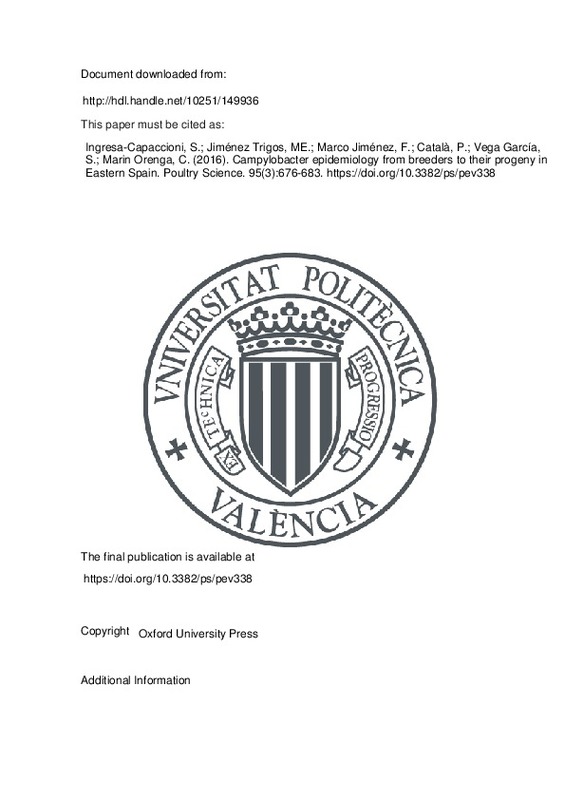JavaScript is disabled for your browser. Some features of this site may not work without it.
Buscar en RiuNet
Listar
Mi cuenta
Estadísticas
Ayuda RiuNet
Admin. UPV
Campylobacter epidemiology from breeders to their progeny in Eastern Spain
Mostrar el registro sencillo del ítem
Ficheros en el ítem
| dc.contributor.author | Ingresa-Capaccioni, S
|
es_ES |
| dc.contributor.author | Jiménez Trigos, María Estrella
|
es_ES |
| dc.contributor.author | Marco Jiménez, Francisco
|
es_ES |
| dc.contributor.author | Català, Pablo
|
es_ES |
| dc.contributor.author | Vega García, Santiago
|
es_ES |
| dc.contributor.author | Marin Orenga, Clara
|
es_ES |
| dc.date.accessioned | 2020-09-12T03:34:31Z | |
| dc.date.available | 2020-09-12T03:34:31Z | |
| dc.date.issued | 2016-03 | es_ES |
| dc.identifier.issn | 0032-5791 | es_ES |
| dc.identifier.uri | http://hdl.handle.net/10251/149936 | |
| dc.description.abstract | [EN] While horizontal transmission is a route clearly linked to the spread of Campylobacter at the farm level, few studies support the transmission of Campylobacter spp. from breeder flocks to their offspring. Thus, the present study was carried out to investigate the possibility of vertical transmission. Breeders were monitored from the time of housing day-old chicks, then throughout the laying period (0 to 60 wk) and throughout their progeny (broiler fattening, 1 to 42 d) until slaughter. All samples were analyzed according with official method ISO 10272:2006. Results revealed that on breeder farms, Campylobacter isolation started from wk 16 and reached its peak at wk 26, with 57.0% and 93.2% of positive birds, respectively. After this point, the rate of positive birds decreased slightly to 86.0% at 60 wk. However, in broiler production all day-old chicks were found negative for Campylobacter spp, and the bacteria was first isolated at d 14 of age (5.0%), with a significant increase in detection during the fattening period with 62% of Campylobacter positive animals at the end of the production cycle. Moreover, non-positive sample was determined from environmental sources. These results could be explained because Campylobacter may be in a low concentration or in a non-culturable form, as there were several studies that successfully detected Campylobacter DNA, but failed to culture. This form can survive in the environment and infect successive flocks; consequently, further studies are needed to develop more modern, practical, cost-effective and suitable techniques for routine diagnosis. | es_ES |
| dc.description.sponsorship | We thank the ASAV (Valencian Poultry Association) and the Santander bank for the financial support of the project and the staff of the CECAV (Center for Poultry and Animal Feed Quality of the Valencian Region) for their assistance. Sofia Ingresa was supported by a research grant from the Spanish Ministry of Education (programme FPU13/03306). English text version was revised by N. Macowan English Language Service. | es_ES |
| dc.language | Inglés | es_ES |
| dc.publisher | Oxford University Press | es_ES |
| dc.relation.ispartof | Poultry Science | es_ES |
| dc.rights | Reserva de todos los derechos | es_ES |
| dc.subject | Campylobacter | es_ES |
| dc.subject | Broiler | es_ES |
| dc.subject | Epidemiology | es_ES |
| dc.subject | Hen | es_ES |
| dc.subject | Transmission | es_ES |
| dc.subject.classification | PRODUCCION ANIMAL | es_ES |
| dc.title | Campylobacter epidemiology from breeders to their progeny in Eastern Spain | es_ES |
| dc.type | Artículo | es_ES |
| dc.identifier.doi | 10.3382/ps/pev338 | es_ES |
| dc.relation.projectID | info:eu-repo/grantAgreement/MECD//FPU13%2F03306/ES/FPU13%2F03306/ | es_ES |
| dc.rights.accessRights | Abierto | es_ES |
| dc.contributor.affiliation | Universitat Politècnica de València. Departamento de Ciencia Animal - Departament de Ciència Animal | es_ES |
| dc.description.bibliographicCitation | Ingresa-Capaccioni, S.; Jiménez Trigos, ME.; Marco Jiménez, F.; Català, P.; Vega García, S.; Marin Orenga, C. (2016). Campylobacter epidemiology from breeders to their progeny in Eastern Spain. Poultry Science. 95(3):676-683. https://doi.org/10.3382/ps/pev338 | es_ES |
| dc.description.accrualMethod | S | es_ES |
| dc.relation.publisherversion | https://doi.org/10.3382/ps/pev338 | es_ES |
| dc.description.upvformatpinicio | 676 | es_ES |
| dc.description.upvformatpfin | 683 | es_ES |
| dc.type.version | info:eu-repo/semantics/publishedVersion | es_ES |
| dc.description.volume | 95 | es_ES |
| dc.description.issue | 3 | es_ES |
| dc.identifier.pmid | 26628341 | es_ES |
| dc.relation.pasarela | S\303998 | es_ES |
| dc.contributor.funder | Santander Universidades | es_ES |
| dc.contributor.funder | Asociación Avícola Valenciana | es_ES |
| dc.contributor.funder | Ministerio de Educación, Cultura y Deporte | es_ES |







![[Cerrado]](/themes/UPV/images/candado.png)

